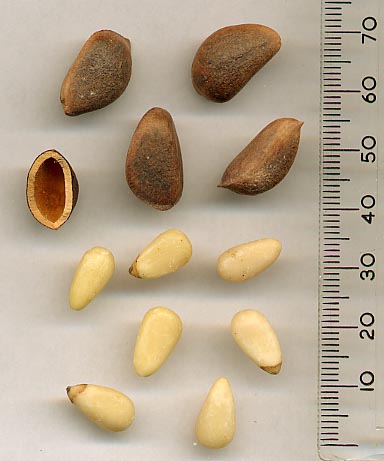 Pine nuts are the edible seeds of several species of pine tree. The main species of pines used for pine nut production are the stone pine (Pinus pinea), Korean pine (Pinus koraiensis), chilgoza pine (Pinus gerardiana), and the North American pinyon pines, including the Colorado pinyon (Pinus edulis), single-leaf pinyon (Pinus monophylla), and Mexican pinyon (Pinus cembroides). We have 5 seeds (Pinus pinea) in pots, having stratified them in the fridge for the requisite 5 weeks (until they began to germinate) then planted them out into tree tubes; No sign yet of green shoots, but I’m still hopeful that spring will see baby pine trees emerging.
Pine nuts are the edible seeds of several species of pine tree. The main species of pines used for pine nut production are the stone pine (Pinus pinea), Korean pine (Pinus koraiensis), chilgoza pine (Pinus gerardiana), and the North American pinyon pines, including the Colorado pinyon (Pinus edulis), single-leaf pinyon (Pinus monophylla), and Mexican pinyon (Pinus cembroides). We have 5 seeds (Pinus pinea) in pots, having stratified them in the fridge for the requisite 5 weeks (until they began to germinate) then planted them out into tree tubes; No sign yet of green shoots, but I’m still hopeful that spring will see baby pine trees emerging.
The trees are long lived and relatively slow growing, evergreen and coniferous. Stone pines are well adapted to (and native to) the Mediterranean region, and thus also well adapted to Perth’s climate. Stone pines planted in areas with more than 400 mm annual rainfall produce greater yields of nuts, although the trees can survive in drier climates; the minimum rainfall for stone pines is considered to be around 250 mm per year, and 600 mm per year is considered to be the optimum. It does not appear to suffer from light frosts, and can survive well down to -10 degrees C. The tree tolerates calcareous soils, but it prefers acid or sub-acid siliceous and sandy soils.
 A mature stone pine averages 12 – 20 m in height, but may be taller. The tree is bushy when young, but at maturity it has an easily recognised ‘umbrella’ shape, with a broad, flat crown of foliage at the top of the trunk. Leaves are flexible and needle-like, as is typical of most pine species, blue-green in colour and 10 – 20 cm long. The seed-bearing cones are 8 – 10 cm long, and take 3 years to mature fully. The seeds are 2 cm long, pale beige or brown with a powdery black coating that rubs off easily, and have a rudimentary wing that falls off very easily. The nuts are ready to harvest about 10 days before the green cone begins to open. Cones are collected and dried in the sun, then smashed to release the seeds. The nuts, once separated from fragments of pine cone, have a second shell which must be removed before eating.
A mature stone pine averages 12 – 20 m in height, but may be taller. The tree is bushy when young, but at maturity it has an easily recognised ‘umbrella’ shape, with a broad, flat crown of foliage at the top of the trunk. Leaves are flexible and needle-like, as is typical of most pine species, blue-green in colour and 10 – 20 cm long. The seed-bearing cones are 8 – 10 cm long, and take 3 years to mature fully. The seeds are 2 cm long, pale beige or brown with a powdery black coating that rubs off easily, and have a rudimentary wing that falls off very easily. The nuts are ready to harvest about 10 days before the green cone begins to open. Cones are collected and dried in the sun, then smashed to release the seeds. The nuts, once separated from fragments of pine cone, have a second shell which must be removed before eating.
Pine nuts contain up to 34% protein, depending on species, and are also high in fibre and oil. They are frequently added to salads and baked goods, and are an essential component of traditional pesto. Pine nuts can be pressed to extract pine nut oil, a mild, nutty flavoured edible oil. Unshelled pine nuts have a long shelf life if kept dry and refrigerated, but shelled nuts (and unshelled nuts in warm conditions) quickly become rancid. Aside from shelling, pine nuts don’t need any special treatment or preparation. They can be eaten raw or cooked, whole, chopped, or ground.
 Pesto
Pesto
Pesto is traditionally made with pine nuts, but can be made with virtually any nuts, or even seeds such as pepitas. Similarly, the basil can be replaced with other herbs, or even with baby spinach leaves.
1/4 – 1/3 cup pine nuts, toasted or raw
2 – 4 cups fresh basil leaves (you may replace some or all of the basil with spinach, parsley, etc.)
approx. 1/2 cup good quality olive oil
1/4 – 2/3 cup freshly grated parmesan or pecorino cheese
2 cloves garlic, minced
salt to taste (approx. 1 tsp)
freshly ground black pepper to taste
Instructions
- Combine basil, pine nuts, olive oil and garlic in a blender, and process until smooth.
- Add the remaining ingredients and process until smooth.
- Store in jars in the fridge until use. Pesto can be frozen, and thawed prior to use. If storing for more than a few hours in the fridge, and if freezing, drizzle a little extra olive oil over the top to avoid oxidation of the basil paste.
Images sourced from Wikimedia Commons: